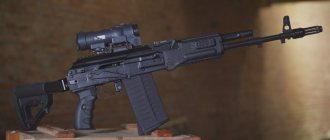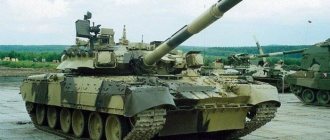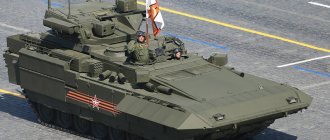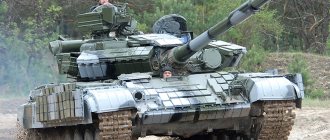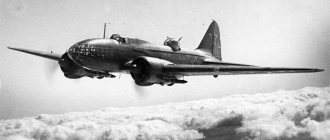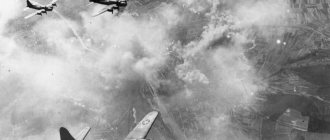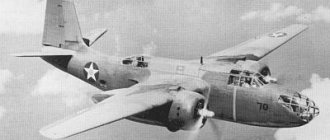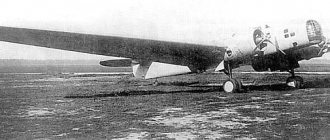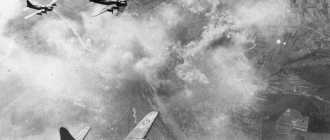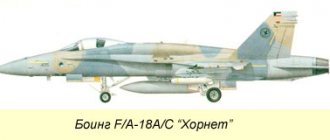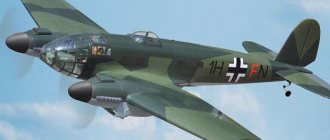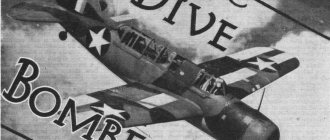Tu-160 and B-1B. At the level of concepts
Experienced B-1A. Then it was a high-altitude supersonic bomber. US Air Force Photo
The American strategic bomber Rockwell B-1B Lancer and the Russian Tu-160 aircraft are quite similar in appearance. However, they differ significantly in tactical and technical characteristics and combat capabilities. These differences are primarily due to the use of two completely different concepts, as well as the specifics of technology development and changes in customer requirements.
First try
Research on the topic of a promising multi-mode strategic bomber began in the United States back in the early sixties. By the end of the decade, a competition began to develop the project, which was won by North American Rockwell in 1970. The promising aircraft received the official designation B-1A.
Tu-160 in flight. Photo by the Russian Ministry of Defense
The Air Force planned to obtain a bomber capable of breaking through enemy air defenses and striking targets at great depths. It was proposed to carry out the breakthrough at high altitude due to supersonic speed. It was assumed that enemy defenses would not be able to detect the bomber in time and shoot it down before the combat load was released. The latter were considered bombs and missiles with a special warhead.
In 1971, the development company built a full-size mock-up of the future B-1A, and in 1974 the first prototype was rolled out. The first flight took place in December of the same year. Flight tests showed that the aircraft generally meets the customer's requirements, but still needs fine-tuning. At high flight altitudes, a speed of up to 2.2 M was ensured - with maximum sweep. With minimal sweep, the bomber showed good takeoff and landing characteristics.
One of the experimental B-1As in the museum. Photo: Wikimedia Commons
According to the plans of that time, serial production could begin in the second half of the seventies, and the achievement of initial operational readiness was ensured by 1979-80. During the eighties it was planned to carry out rearmament.
Soviet response
Also in the late sixties, the Soviet program to develop a new bomber began.
In 1969, the Air Force issued requirements that required the development of a multi-mode aircraft with supersonic speed and long range. It was planned that such a machine would reach the line at high altitude and high speed and launch long-range missiles. Due to this, it was proposed to ensure a breakthrough of the enemy’s air defense - or eliminate the need to enter its affected area. It is believed that by the time the assignment for the future Tu-160 was developed, the Soviet military knew about the American project. This influenced the development of our own equipment and ultimately led to a certain external similarity between the two finished machines. However, the differences between the two aircraft appeared already at the design stage.
Tu-160 on takeoff. Photo by UAC
In 1972, the customer compared several preliminary designs from different organizations, and further design was entrusted to OKB A.N. Tupolev. Subsequently, the project was revised and reworked several times; the final preliminary design was approved only in 1977, which made it possible to begin preparing documentation for the construction of a prototype.
The first flight of the experimental Tu-160 took place in December 1981. Subsequently, several prototype series aircraft were built to carry out all stages of testing. State tests were completed in 1989 with a recommendation for adoption. By that time, several aircraft had entered the Air Force units for trial operation, and soon mass production began.
Cancellation and replacement
In 1976, American experts were able to familiarize themselves with the equipment of the hijacked MiG-25 interceptor and assess the potential of Soviet air defense. It was found that the high-altitude supersonic B-1A has minimal chances of breaking through to targets on the territory of the USSR and in this respect is almost no different from the subsonic B-52. The future of the Rockwell project is in doubt.
An upgraded B-1B drops an AGM-158 missile. US Air Force Photo
In mid-1977, the US military and political leadership decided to abandon the B-1A. Instead of producing such vehicles, it was proposed to rearm the existing B-52s, as well as strengthen the ground component of nuclear forces. In addition, a program to develop a promising stealth bomber was soon launched, which later resulted in the B-2A.
A few years later, the B-1A was remembered, and in early 1982, Rockwell received a new contract to develop a strategic bomber. The existing B-1A had to be redesigned to meet updated requirements, since the Air Force now wanted a long-range bomber with a different method of breaking through air defenses. The future B-1B was supposed to fly to the target at transonic speed at low altitude while skirting the terrain.
The original aircraft was significantly redesigned. It has become heavier, has new controls, new safety systems, etc. To increase survivability, the electronic warfare system was improved. All this work did not take much time, and already in 1983 the first experimental B-1B Lancer was rolled out. The first production one was delivered to the Air Force in the fall of 1984. Production continued until 1988; Exactly 100 aircraft were built.
Russian bomber undergoing repair and modernization. Photo by PJSC Tupolev
New era
Thus, by the end of the Cold War, the two superpowers had new strategic bombers - similar in appearance, but different in design and capabilities.
In addition, differences in the potential of aircraft were determined by their number. During the eighties, the United States managed to build its B-1B in a fairly large series, several times larger than the production of Soviet and Russian Tu-160s. Due to the difficult economic situation, Russia could not continue the massive construction of new bombers. In addition, any measures to modernize the Tu-160 were called into question. It was possible to return to this only at the beginning of the 21st century.
During the same period, work began in the United States to update and improve the B-1B. The aircraft were able to carry and use a wider range of ammunition, and combat characteristics were also increased due to new sighting and navigation systems. At the same time, nuclear weapons were excluded from the ammunition load, and the corresponding on-board instruments were removed.
Experiments with the suspension of a prototype hypersonic missile on the B-1B. US Air Force Photo
Ways of modernization
In recent decades, Russian industry has modernized Tu-160 aircraft and expanded their capabilities.
In particular, the ammunition load has been seriously expanded. Previously, the main weapon of bombers was the X-55 strategic cruise missile. On its basis, the non-nuclear product X-555 was created. A new generation of Kh-101/102 missiles has also been introduced. It is possible to use free-falling and guided bombs of various types. Projects for deep modernization of the Tu-160M/M2 have been developed, and they do not provide for changes in application concepts. After modernization in the nineties, the main weapon of the B-1B Lancer became unguided and “smart” bombs of various types. Later, it became possible to use AGM-158 JASSM missiles. Recently, the possibility of equipping the B-1B with advanced weapons, including hypersonic missiles, has been repeatedly mentioned. It is unclear how quickly such products will enter service.
After all the upgrades, the Russian Tu-160 remains a supersonic high-altitude bomber, whose main task is to deliver cruise missiles to the launch line. The aircraft performed it both during numerous exercises and as part of the Syrian operation. Thus, the basic concept of the project, developed half a century ago, has remained virtually unchanged and still makes a significant contribution to the country’s defense capability.
Dropping an X-55 missile from the cargo compartment of a Tu-160. Photo by the Russian Ministry of Defense
American B-1A/B projects cannot boast of such “stability”. The original project was closed and reworked, changing its key provisions. The supersonic missile carrier turned into a transonic bomb carrier and lost its nuclear weapons, but then again acquired missiles. In addition, modern techniques provide for high-altitude flight as the main method of combat use, which brings to mind the experienced B-1A.
Stability versus change
The Russian Tu-160 bomber, undergoing new modernizations, retains its place in the Air Force and Strategic Nuclear Forces.
He performs the originally intended tasks, although he receives new weapons and functions - and at the same time he is respected. Its American “colleague”, the B-1B, was less fortunate. He is considered perhaps the most unsuccessful representative of US strategic aviation. It is highly likely that these results from the two projects are directly related to the use and development of the underlying concepts. The aircraft, brought into service in its original form, turned out to be more successful and has great prospects. The other sample, after all the alterations and modifications, is planned to be replaced at the first opportunity. And the external resemblance to the Russian Tu-160, it seems, will not save it.
New in blogs
Prehistoria
After the B-52 strategic bombers entered service, American strategists began to think about what the next step should be. It would be logical to build a supersonic strategic bomber, with maximum speed and maximum altitude. This was in the first half of the 50s, and these two indicators seemed decisive for breaking through enemy air defenses. The military decided that they needed strategic bombers with a maximum speed of M3.3, a cruising speed of M3 and a service ceiling of more than 23 km. The designers of North American Aviation strained themselves and on September 21, 1964, the XB-70 Valkyrie took off.
And in the spring of 1966, Valkyrie climbed to a height of 23 km, overcame triple the speed of sound and entered cruising flight mode 3M. But even before the first flight, in 1962, the concept of an ultra-high-speed high-altitude strategic bomber was abandoned and the Valkyrie, even on its very first flight, was sent in the status of an “experimental aircraft” and not a prototype bomber. The reason was simple: speed and altitude no longer guaranteed the ability to break through the air defenses of a potential enemy. Air defense anti-aircraft missile systems forced a change in the concept of the future strategic bomber. The XB-70 passed from the Air Force to NASA, and in 1969 it took its place in the museum.
The USSR “accepted the challenge” and the Sukhoi Design Bureau created the T-4 Sotka - a 3-mach bomber, albeit smaller than the Valkyrie
Sotka's first flight took place 3 years after Valkyrie found a new home - in a museum. The T-4 completed 10 test flights and suddenly the project was closed. Someone saw the Valkyrie in the museum and reported to the Central Committee that the Americans abandoned the 3-mach aircraft in favor of slower, lower-altitude bombers with variable wing geometry. In January 1974, Sotka was closed, and in November of the same year, the Rockwell B-1A took off for the first time in the United States. Accordingly, by “highest command” Sukhoi and Myasishchev transferred all developments on the subject of a supersonic strategic bomber to their teacher, Andrei Nikolaevich Tupolev. Myasishchev made a project almost completely repeating the B-1A. It was on Myasishchev’s project that the Tu-160 project was based.
History B-1(A/B)
In the first half of the 60s of the twentieth century, the ideology of designs with variable wing geometry was formed in the world of aviation. This idea was discussed by the Germans during the war, and then it was developed in the USA and England. The F-111 began flying in 1964. A little earlier, Rockwell began designing the future B-1, as part of the Advanced Manned Strategic Aircraft (AMSA) program. The idea of a strategic bomber with variable wing geometry was adopted as the basis. In April 1969, the aircraft received the official name B-1A, and on November 23, 1974, the first aircraft took off.
It was a fairly high-speed (M2.5), fairly high-altitude (up to 19 km) bomber with a decent range (up to 10 thousand km), capable of carrying up to 34 tons of bomb load (the subsonic B-52 took slightly less bombs - up to 31.2 tons ). The military was pleased, but President Carter froze the program. When Reagan replaced what most Americans consider to be the country's worst president of the 20th century, the program received a second wind. And the military also formed new demands.
Since neither high altitude nor high supersonic speed promised an air defense breakthrough, they asked the designers to ensure that the radar signature was as small as possible and that the air defense breakthrough took place at an ultra-low altitude, skirting the terrain, following the example of the F-111. At the same time, the military did not object to the radical reduction in maximum speed at altitude. The new modification was called B-1B.
Rockwell designers introduced ultra-low-altitude flight technologies with terrain-following at high subsonic speeds, installed a radar with a passive phased array and a synthetic aperture, increased the bomb load and raised the range to 12 thousand km, and added some technologies that reduce radar signature. Of course, the B-1B is not stealth, but its frontal ESR was reduced to 0.77-0.78 sq.m.
With such radar visibility, at an altitude of 60 meters, and at a speed of over 1100 km/h, even now the chances of breaking through the most modern Russian air defense systems are estimated at 85%.
On October 2, 1981, Ronald Reagan announced an order for hundreds of B-1B bombers. After 2 years, the company began mass production in 5 years, and until 1988, produced exactly 100 aircraft of this model. To date, the US Air Force has 61 B-1B aircraft in service.
Tu-160
Having learned that the Americans abandoned the Valkyrie in favor of the B-1, the Soviet leadership decided that the Americans had chosen a rational direction. For the past 4 years, the GRU has been diligently bringing to Myasishchev all the design and technological information obtained on the original version of the B-1A. When the decision was made to transfer the development of a supersonic strategic bomber into the hands of Tupolev, the developments of the Sukhoi Design Bureau and the draft copy of the B-1 from the Myasishchev Design Bureau smoothly migrated to the Andrei Nikolaevich Design Bureau. The decision to transfer the project to Tupolev was not accidental - they had well mastered the process of copying American and European aircraft.
Tupolev tried very hard, but the level of technology in the Soviet aviation industry did not allow him to copy the American aircraft 1:1. As you know, “Soviet microchips are the largest microchips in the world!” Miniaturization was a bad thing; all components and assemblies turned out to be larger in size and heavier. We had to slightly increase the size and weight of the aircraft, but we were able to add a little bomb load. And it turned out to be the Tu-160.
In 1995, on the 50th anniversary of the victory over Nazi Germany, veteran American pilots arrived in Ukraine, at the airfield where Tu-160s of the Ukrainian Air Force (not yet destroyed) were based, carrying out “shuttle” operations to bomb the Reich. They were received with great honor and respect, and at the end of the event, they were allowed to enter the pilot’s cockpit of the Tu-160. The American veterans were amazed - many of the instruments were well known to them from the B-29.
It turns out that Tupolev began copying American aircraft precisely from these same B-29s. Of course, a lot of new things appeared, joysticks appeared instead of steering wheels, a couple of kinescope screens, but the layout and many of the devices were transferred from the Tu-4 “Superfortress”. Still, this is not a Lancer
Below I provide a comparison table of the characteristics of all 3 aircraft. Draw your own conclusions.
| Characteristic | Unit Change | Tu-160 | V-1A | B-1B |
| Crew | people | 4 | 4 | 4 |
| Length | m | 54.1 | 46 | 46 |
| Wingspan | ||||
| at minimum sweep angle | m | 55.7 | 41.67 | 41.67 |
| at maximum sweep angle | m | 36.5 | 23.84 | 23.84 |
| Minimum sweep angle | hail | 20 | 15 | 15 |
| Maximum sweep angle | hail | 65 | 67.5 | 67.5 |
| Height | m | 13.1 | 10.24 | 10.24 |
| Empty mass | T | 110 | 64.86 | 86.18 |
| Maximum take-off weight | T | 275 | 176.8 | 216.365 |
| Service ceiling | m | 16000 | 18900 | 18290 |
| Flight at ultra-low altitude with terrain following | No | No | Yes | |
| Cruising speed | km/hour | 960 | 1150 | 1150 |
| Practical range without refueling | km | 12300 | 9812 | 12000 |
| Maximum speed at an altitude of 12 km | km/hour | 2220 | 2300 | 1328 |
| Maximum speed / at breakout height | km/h/m | 1030/300 | n/a | 1160/30 |
| Combat load | kg | 40000 | 34020 | 60690 |
| Frontal EPR (dispersion area effect) | sq.m. | 27.8 | 32.46 | 0.77 |
| Number of aircraft in service | PC | 16 | 0 | 61 |
And for a snack - a film from the Famous Airplanes series.
The expert compared the winged pride of Russia Tu-160 with the American strategic bomber B-52
During the Cold War era, the United States and the Soviet Union spent several decades intimidating each other with the threat of destroying the enemy with nuclear weapons. Millions of people and countless resources were spent on developing and deploying weapons systems equipped with the latest technology to ensure the complete destruction of an enemy state should the Cold War become hot.
During this arms race, both sides developed bombers capable of crossing oceans and continents to drop nuclear bombs directly on enemy territory. Subsequently, when this became impossible due to the improvement of air defense systems, missiles began to be placed on these aircraft to be launched as close as possible to the target. It seems incredible that some of these engineering marvels from the 1950s to 1970s are still flying today, 26 years after the collapse of the Soviet Union and the end of the Cold War they were designed to fight.
The grandchildren of their first pilots sit at the controls of some aircraft, and these devices do not lose their effectiveness. They are being modernized so as not to be removed from service, for example, the American B-52 or the Russian Tu-95 (Bear - “Bear” according to NATO classification), or their production is being resumed to produce new models, in particular, the Russian Tu-160. The giants of the Cold War will remain with us for many years, some of them will last more than a hundred years, which is an eternity for an airplane.
Boeing B-52 Stratofortress
The contract for the development of the B-52 strategic bomber was concluded in 1946, the first flight of this device took place on April 15, 1952, and in 1955 it was put into service with the US Air Force. After 62 years, this modernized and modified aircraft continues to fly and participate in combat operations. The B-52 Stratofortress (flying fortress) was developed as an intercontinental jet bomber carrying unguided nuclear bombs to attack cities and strategically important infrastructure of the USSR.
Soviet supersonic strategic bomber Tu-160
Nuclear bombs have never been dropped from these aircraft, which have been used for operational and tactical purposes in all armed conflicts involving the United States since the 1965 Vietnam War. But they dropped thousands of tons of unguided and guided bombs with conventional charges, and now they continue to roam the skies, sometimes piloted by the grandchildren of their first commanders. Among themselves, the pilots call this bomber Buff. This is an acronym formed from the words Big Ugly Fat Fucker (big, ugly, fat guy).
The length of the aircraft is 48.5 meters, the wingspan is 56.4 meters, the wing area is 370 square meters. The height of the vertical stabilizer is 12.4 meters, the empty weight of the aircraft is 83.25 tons, the maximum take-off weight is 220 tons, which allows it to carry 31.5 thousand kilograms of weapons and 181 thousand liters of fuel.
The bomber has swept wings (sweep angle 35 degrees), from which hang four twin compartments with TF-33 turbojet engines manufactured by Pratt & Whitney. The device can reach a maximum speed of 1046 km/h (650 mph or Mach 0.86). The maximum flight range without in-flight refueling is 14 thousand kilometers (the ferry range is more than 16 thousand kilometers), but when refueling in the air, the maximum flight range depends on the endurance of the crew. The plane can fly at altitudes of up to 15.24 thousand meters. The crew consists of five people (commander, co-pilot, navigator, radio operator-gunner and electronics engineer), although sometimes it also included gunners to fire anti-aircraft guns removed from the vehicle in its latest modifications.
Designed to carry a large bomb load, the B-52 features a large internal cargo bay and four underwing weapons suspension systems, allowing the vehicle to carry a variety of unguided and guided bombs (nuclear, cluster and conventional), as well as air-to-surface missiles, designed to strike both ground and surface targets, mines, electronic suppression systems with a total weight of up to 31.5 tons. A total of 744 aircraft were built in eight modifications (from A to H), the last aircraft left the factory floor on October 26, 1962.
As new models of the bomber were developed, its design and the electronic equipment installed on board were improved, and the structure of the tail section was changed, including the location of the tail machine guns (which were later removed from the device). The aircraft were also equipped with new target designators, electronic warfare systems, and modified engine models with higher power and lower fuel consumption. Currently, the US Air Force has about 70 B-52 bombers in full combat readiness, and another 20 are in reserve. All devices belong to modification H and have been modernized to extend their service life.
The first combat missions of these aircraft, originally designed for participation in nuclear war, were the so-called carpet bombing using unguided conventionally charged bombs (during the Vietnam War) similar to those used during World War II. Throughout the American Gulf War, B-52s carried out high-altitude bombing missions as well as low-altitude strikes, including missile strikes.
Today, American strategic bombers are used in Syria, Afghanistan and Iraq as high-altitude support aircraft using guided munitions. Due to their combat radius and high survivability, these vehicles are ideal “flying arsenals” for dropping guided bombs (laser-guided or GPS) on command from the ground. Equipping aircraft with the Litening module since 2007 has made it possible to use them to perform the above-mentioned tasks. In addition, the B-52 can be used for maritime patrols and can carry mines or Harpoon missiles. The speed and range of the bomber allows it to fly over vast areas during search operations.
During the B-52's long service, at least 11 aircraft were lost in crashes, including a B-52G that collided with a KC-135 Stratotanker over Palomares, Almeria, Spain on January 17, 1966. Four thermonuclear bombs on board the bomber fell to the ground, causing radiation contamination of the area. Another 30 aircraft were lost during the Vietnam War: at least ten of them were shot down by the enemy, and five were so seriously damaged that they could hardly reach Allied airfields. In turn, the gunners of two B-52D aircraft shot down two MiG-21 fighters with their tail machine guns. Currently, B-52s continue to fly combat missions in Syria and Iraq, striking the positions of terrorist groups, including the Islamic State, and performing “show of force” flights in high-risk areas. international tensions: the Baltics, Eastern Europe or the South China Sea.
The last B-52 aircraft produced has been in service for 55 years and has tens of thousands of flight hours, but the aircraft's 1950s-style design and repeated upgrades and modifications allow them to remain in service for many years to come. This is precisely what the new proposal to replace the engines of American bombers, their weakest link, is aimed at. The US Air Force has requested about ten million dollars to study options to replace the latest version of the TF-33 Pratt & Whitney engines with the most modern power plants, which should reduce the cost of operating the aircraft (cost per flight hour, fuel consumption) and increase flight range.
The cost of improving the B-52 bomber fleet, including rebuilding the cargo bay to allow it to be loaded with guided munitions, is $227 million. In the period from 2022 to 2022, it is expected to spend $1.34 billion on modernizing radar installations and equipping devices with new systems. The US Air Force intends to continue operating the Buffs until 2040, when the aircraft will be 100 years old. And he will continue to bomb.
Tu-160 "White Swan"
The Soviet equivalent of the American B-52 was essentially the swept-wing Tu-95 turboprop strategic bomber, designed to perform the same combat missions in the same era, which also continues to operate today. But a more interesting example in terms of modernization is, without a doubt, the successor of this aircraft - the Tu-160 “White Swan” (Blackjack - “Blackjack” according to NATO classification). This aircraft belongs to the next generation of bombers, and it is truly worthy of respect.
The Tu-160, whose development began on a competitive basis in 1972, was supposed to become a competitor to the American XB-70 Valkyrie or B-1A models, which were never put into service. As part of this mission, the Tupolev Design Bureau created a monster: the world's largest and heaviest combat aircraft with variable wing geometry, capable of reaching speeds twice the speed of sound, and the world's fastest bomber currently in service. All this was so expensive that today there are only 16 of these devices left that can be used. But they have such potential that the Russian Ministry of Defense plans to resume production of this aircraft.
In appearance, the Tu-160 resembles an enlarged version of the American Rockwell B-1 Lancer aircraft. The Russian bomber is larger than its American counterpart (length - 54.1 meters compared to 44.5 meters; maximum wingspan - 55.7 meters compared to 41.8 meters), it is heavier (maximum take-off weight - 275 tons compared to 216 tons), faster (maximum speed - Mach 2 compared to Mach 1.25), can carry more weapons in the cargo bay (40 tons compared to 34 tons). It was developed as a missile carrier, the cargo compartments are equipped with two drum launchers, each of which can carry six X-55 cruise missiles (with conventional and nuclear charges and a range of up to 2.5 thousand kilometers) or 12 X-15 aeroballistic hypersonic missiles (nuclear or anti-ship) short range (up to 300 kilometers).
The maximum flight range of the Tu-160 without in-flight refueling is 12.3 thousand kilometers, the combat radius is about 7 thousand kilometers, it is equipped with an aerial refueling receiver boom, which is used in rare cases. The maximum flight altitude is 15 thousand meters. Although the aircraft was not built using Stealth technology, a number of design features reduce its radar signature, for example, compared to the B-52.
In April 1987, the 184th Guards Poltava-Berlin Red Banner Heavy Bomber Aviation Regiment in Priluki (on the territory of the Ukrainian SSR) was equipped with Tu-160 bombers, but after the release of 36 devices, the collapse of the Soviet Union occurred, which influenced the further fate of the Tu-160.
After the USSR ceased to exist in 1991, Ukraine nationalized all Armed Forces located on its territory. At the airfield in Priluki there were 19 “White Swans”, which were appropriated by Ukraine, although most of the pilots and aircraft technicians chose to go to Russia.
In the 90s, these aircraft gradually failed due to the lack of necessary repair and restoration services. Russia and Ukraine were negotiating the possible sale of these aircraft. Ukraine did not need them, but the requested price (about $3 billion) was too high for Moscow. After much wrangling and the disposal of one device under the treaty on nuclear disarmament of Ukraine, the parties came to an agreement: taking into account the write-off of part of the gas purchase debt, Russia had to pay Ukraine $285 million for eight Tu-160s, which are in the best condition, three Tu-95MS and 575 Kh-55M missiles. After the necessary training, from November 1999 to February 2001, the Tu-160s were relocated to a Russian airbase near the city of Engels, Saratov region.
The 121st Guards Sevastopol Heavy Bomber Aviation Regiment, based at the airfield near Engels, already had six Tu-160 aircraft, to which were added eight more bombers transferred by Ukraine, and several aircraft that were being completed by the Russian Ministry of Defense after the collapse of the USSR. After a number of plane crashes and the commissioning of new missile carriers, the Russian Air Force now has 16 Tu-160s (in the Tu-160M modification), although it is believed that only 11 of them are in a state of full combat readiness. These devices carried out demonstration flights in South America (in 2008 in Venezuela and in 2013 in Colombia). In November 2015, Tu-160 bombers took part in combat operations for the first time, carrying out cruise missile strikes against targets in Syria.
Considering the power and potential of these devices, it is not surprising that the Russian Ministry of Defense wanted to increase the Tu-160 fleet. An idea emerged to resume production of these aircraft (one aircraft every two to three years) and increase their number to 30 by 2030-2040. The missile carriers will be produced in the Tu-160M2 modification and, according to official data, will be equipped with 60% new components, including new power plants, which should increase the Tu-160’s flight range by approximately a thousand kilometers and flight altitude to 18 thousand meters.
It is planned to integrate the latest high-precision instruments into the aircraft’s on-board system, which will allow shooters to use “smart” ammunition, as well as radar systems and communications of the latest generation. Another important change will be the replacement of all Ukrainian-made equipment, since now, when relations between Russia and Ukraine are tense, its import is impossible. The resumption of production of the Tu-160 will slow down the implementation of the program for the development of a promising long-range aviation complex (PAK DA), but will extend the service life of the device, which in this case can remain in service for more than 50 years. And then no one will be able to say that the “old people” are good for nothing.
Author: Pepe Cervera, El Confidencial, Spain. The translation of the Internet project “InoSMI.Ru” was used.
Experts from the American military magazine The National Interest compared the combat potential of the Russian strategic bomber Tu-160 (according to NATO codification: Blackjack) and the US Air Force B-1 aircraft. As foreign analysts noted, the Tu-160 has superiority over the B-1 in speed. Especially for its readers, PolitRussia presents an exclusive retelling of the material.
The Tu-160 and B-1 bombers are very similar, but they are completely different aircraft, writes NI. The B-1A was originally designed as a high-altitude supersonic bomber, but the program was frozen when it became clear that the new aircraft would not be able to survive against Soviet air defense systems. Already under the new administration in Washington, the bomber project received new life. The Pentagon did not rely on the ability of aircraft to fly at supersonic speeds at high altitudes, but optimized it for low altitudes.
wikipedia.org/Public Domain
The updated B-1B has lost speed: instead of Mach 2.0, it is now only 1.25. At the same time, the aircraft was made more invisible, including against radar background. Then, in the early 2000s, the Pentagon modernized the bomber, upgrading the aircraft's targeting system to the Sniper XR.
The Pentagon used the B1-B bomber for military operations in Iraq and Afghanistan, where one of its weaknesses was revealed: the American aircraft would not be able to operate in an area where the enemy had a good air defense system.
“The Tu-160 is similar to the B-1B, but it is a completely different aircraft. The Soviet Union developed Blackjack primarily as a means of delivering a nuclear strike during the Third World War. The Soviet Union designed the jet as a means of delivering nuclear-tipped cruise missiles into enemy territory,” writes NI.
As American experts note, the Tu-160 is much larger and much faster than the B-1B. The Russian bomber has a maximum take-off weight of more than 279 tons and a top speed of more than Mach 2.05. The B-1B has much lower figures: just over 216 tons and Mach 1.25
wikipedia.org / Alex Beltyukov / CC BY-SA 3.0
NI analysts also emphasized that the Tu-160, armed with long-range cruise missiles such as the Kh-55MS, is capable of effectively carrying out assigned tasks even in modern conflicts. At the same time, the article added: in the near future, Russia will equip its army with even more effective modernized Tu-160M2. Moscow will already replace the latter with the promising long-range aviation complex (PAK DA) - this new generation strategic bomber-missile carrier is currently being developed.
Earlier, PolitRussia wrote that NI revealed how anti-Russian sanctions threaten the United States.
